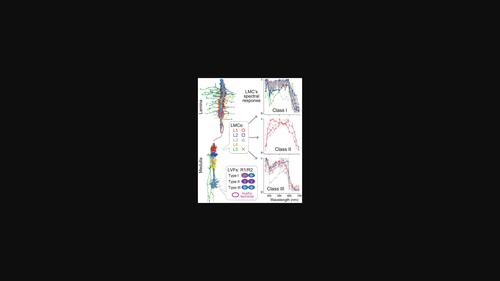当前位置:
X-MOL 学术
›
J. Comp. Neurol.
›
论文详情
Our official English website, www.x-mol.net, welcomes your feedback! (Note: you will need to create a separate account there.)
Morphology and spectral sensitivity of long visual fibers and lamina monopolar cells in the butterfly Papilio xuthus
The Journal of Comparative Neurology ( IF 2.5 ) Pub Date : 2024-01-10 , DOI: 10.1002/cne.25579 Daiki Wakita 1 , Hiromichi Shibasaki 1 , Michiyo Kinoshita 1 , Kentaro Arikawa 1
The Journal of Comparative Neurology ( IF 2.5 ) Pub Date : 2024-01-10 , DOI: 10.1002/cne.25579 Daiki Wakita 1 , Hiromichi Shibasaki 1 , Michiyo Kinoshita 1 , Kentaro Arikawa 1
Affiliation

|
Extensive analysis of the flower-visiting behavior of a butterfly, Papilio xuthus, has indicated complex interaction between chromatic, achromatic, and motion cues. Their eyes are spectrally rich with six classes of photoreceptors, respectively sensitive in the ultraviolet, violet, blue, green, red, and broad-band wavelength regions. Here, we studied the anatomy and physiology of photoreceptors and second-order neurons of P. xuthus, focusing on their spectral sensitivities and projection terminals to address where the early visual integration takes place. We thus found the ultraviolet, violet, and blue photoreceptors and all second-order neurons terminate in the distal region of the second optic ganglion, the medulla. We identified five types of second-order neurons based on the arborization in the first optic ganglion, the lamina, and the shape of the medulla terminals. Their spectral sensitivity is independent of the morphological types but reflects the combination of pre-synaptic photoreceptors. The results indicate that the distal medulla is the most plausible region for early visual integration.
中文翻译:

蝴蝶 Papilio xuthus 长视觉纤维和单极层细胞的形态学和光谱敏感性
对蝴蝶(Papilio xuthus)访花行为的广泛分析 表明,彩色、非彩色和运动线索之间存在复杂的相互作用。它们的眼睛光谱丰富,有六类光感受器,分别对紫外线、紫色、蓝色、绿色、红色和宽带波长区域敏感。在这里,我们研究了P. xuthus的光感受器和二级神经元的解剖学和生理学 ,重点关注它们的光谱敏感性和投影终端,以解决早期视觉整合发生的位置。因此,我们发现紫外线、紫色和蓝色光感受器以及所有二级神经元终止于第二视神经节(髓质)的远端区域。我们根据第一视神经节的树枝化、椎板和髓质末端的形状,识别了五种类型的二阶神经元。它们的光谱敏感性与形态类型无关,但反映了突触前感光细胞的组合。结果表明,远端髓质是早期视觉整合最合理的区域。
更新日期:2024-01-10
中文翻译:

蝴蝶 Papilio xuthus 长视觉纤维和单极层细胞的形态学和光谱敏感性
对蝴蝶(Papilio xuthus)访花行为的广泛分析 表明,彩色、非彩色和运动线索之间存在复杂的相互作用。它们的眼睛光谱丰富,有六类光感受器,分别对紫外线、紫色、蓝色、绿色、红色和宽带波长区域敏感。在这里,我们研究了P. xuthus的光感受器和二级神经元的解剖学和生理学 ,重点关注它们的光谱敏感性和投影终端,以解决早期视觉整合发生的位置。因此,我们发现紫外线、紫色和蓝色光感受器以及所有二级神经元终止于第二视神经节(髓质)的远端区域。我们根据第一视神经节的树枝化、椎板和髓质末端的形状,识别了五种类型的二阶神经元。它们的光谱敏感性与形态类型无关,但反映了突触前感光细胞的组合。结果表明,远端髓质是早期视觉整合最合理的区域。



























 京公网安备 11010802027423号
京公网安备 11010802027423号